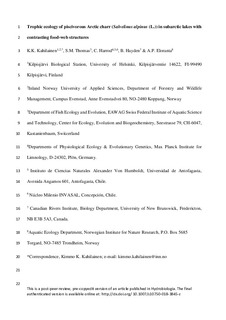Trophic ecology of piscivorous Arctic charr (Salvelinus alpinus (L.)) in subarctic lakes with contrasting food-web structures
Journal article, Peer reviewed
Accepted version

Åpne
Permanent lenke
http://hdl.handle.net/11250/2580685Utgivelsesdato
2018Metadata
Vis full innførselSamlinger
- Publikasjoner fra CRIStin - NINA [2364]
- Scientific publications [1392]
Originalversjon
https://doi.org/10.1007/s10750-018-3845-zSammendrag
The trophic ecology of piscivorous Arctic charr (Salvelinus alpinus (L.); charr) in the food webs of large subarctic lakes is not well understood. We assessed charr diets, parasites, growth, maturity, and stable isotope ratios in Fennoscandian subarctic lakes dominated by monomorphic or polymorphic whitefish (Coregonus lavaretus (L.)) populations. Charr density was low in all lakes, except in profundal habitats. Charr shifted to piscivory at small size (16–25 cm total length) and consumed a range of prey-fish sizes (2–25 cm). Cannibalism was observed in a few individuals from one monomorphic whitefish lake. Charr matured at 37–51 cm (5–8 years old), grew to 52–74 cm maximum observed length and 47–83 cm asymptotic length. Charr increased total area of convex hull and core stable isotopic diversity area of the fish community by 51–98% and 44–51% in monomorphic whitefish lakes, but only 8–11% and 7–10% in polymorphic whitefish lakes. The difference was due to increasing food-chain length in monomorphic whitefish lakes, whereas reliance on littoral carbon did not change. Charr were the top piscivores in monomorphic whitefish lakes, but played a less important role in polymorphic whitefish lakes, which contained a more diverse predator fauna.